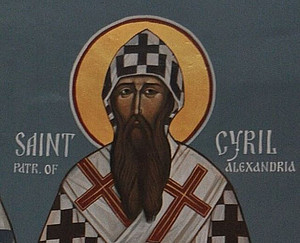Cyril of Alexandria
Valoration: bully & intrigue/ pillar of orthodoxy and seal of the Fathers. Nearly nothing is known of his parentage, but we do know that his education had a firm foundation in biblical studies and he had extensive knowledge of Athanasius and other theologians, including Origen. He served under Theophilus, bishop of Alexandria, and attended the Synod of the Oak with him that deposed John Chrysostom as bishop of Constantinople in 403. After much strife, Cyril succeeded Theophilus as bishop. Many disputes arose between Jews, pagans, and the government during Cyril’s tenure, and he bears part of the blame for the murder of the philosopher Hypatia in 415, which disgraced the Christian Church in Alexandria. In 428 began the most famous controversy of Cyril’s life; it was against Nestorius regarding the doctrine of Christ. The conflict started when N. denied the propriety of the name “Mother of God” for Mary (theotokos). They tried to get one another deposed, both appealing to Emperor Celestine I of Rome. Celestine ruled in favor of Cyril as did the Ecumenical Council of Ephesus in 431. Cyril wrote several letters to Nestorius. on this subject: his second letter to Nestoirius. became regarded as the proper interpretation of the Nicene Creed; his third letter containing twelve anathemas were incorporated into the declaration of the Council. Many of the churches that had either vacillated in the controversy or had sided with N. were reconciled on the basis of the Formula of Union, composed by Cyril as a letter to John of Antioch. He spent the last decade of his life exposing the roots of Nestorianism in Diodore and Theodore and replying to attacks. Cyril died in 444.
Cyril was concerned with proper hermeneutics, esp. of the OT. He employed the allegorical exegesis that had become the standard in Alexandria, but he retained the importance of historia. His works De adoratione spiritu et veritate and Glaphyra both dealt with interpretation of the OT law in light of Christ’s fulfillment of the law. He wrote, too, a commentary on John almost completely extant, which apparently was composed prior to the Nestorian controversy. His commentary on the Gospel of Luke, however, evidently came later, for it is fill with attacks on N.’s teaching. He also commented the De adoratione spiritu et veritate and Glaphyra. A number of anti-Nestorian works also survive. He wrote an apologetic work, to Theodosius II, of which on the first 10 books survive in their entirety.
C. emphasizes the Logos as central in his Christology: it is the Logos that assumes humanity and makes it his own, thus showing a unity of subject. Christ is fully human, but Christ must not be divided into two prosopa by dividing statements about him in Scripture, a practice not in step with the biblical texts anyway. In a letter to Acadius, C. claims to speak of two natures “only in the conceptual realm, because, when he takes the concept seriously, he evidently understands it to mean that which exists in and for itself” (DECL 156). C. especially emphasized the Incarnation as the central saving act of God in Christ, not so much the crucifixion or resurrection.
: His Christology became the standard for the Byzantine church as well as for the West up to the present, thanks to the Council of Chalcedon, which adopted his Christological language. However, his sharp formulation of his doctrine of Christ did push away churches in the East, both the so-called Monophysite church and the so-called Nestorian Church (cf. DECL 157).
“The patristic understanding of the Incarnation owes more to Cyril of Alexandria than to any other individual theologian. The classic picture of Christ the God-man, as it is delineated in the formulae of the Church from the Council of Chalcedon onwards, and as it has been presented to the heart in liturgies and hymns, is the picture Cyril persuaded Christians was the true, the only credible, Christ.” (Whickham
